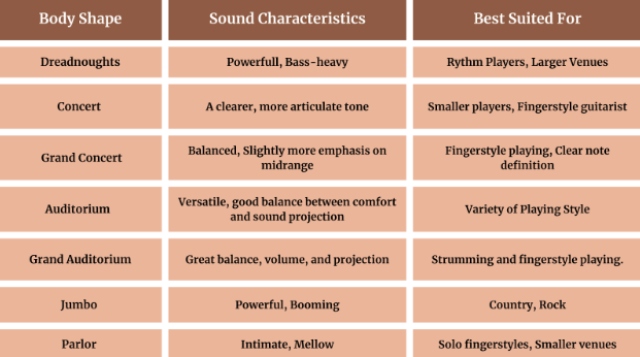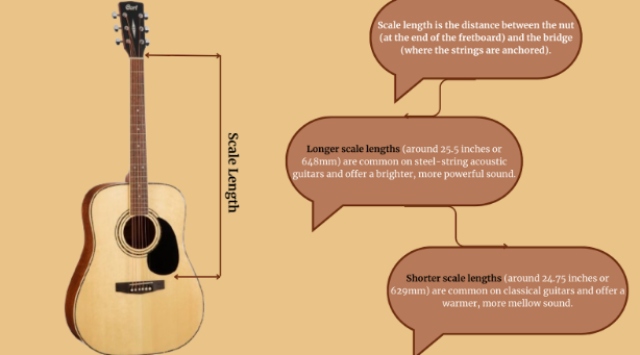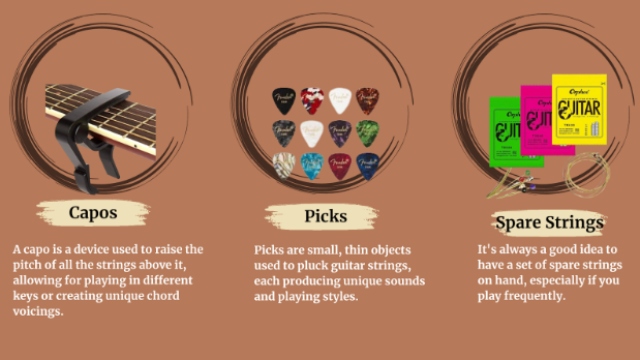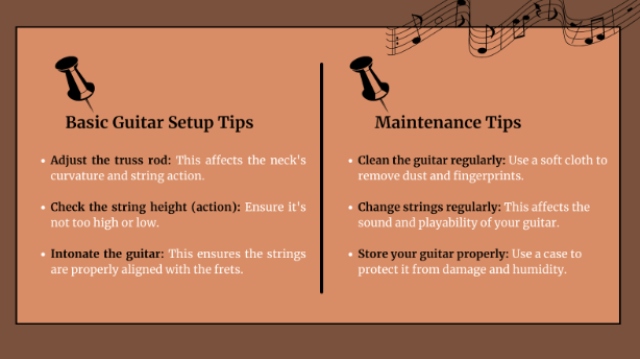[imagesource:flickr]
Are you prepared to strum your way into the world of acoustic guitars? Awesome!
We know there are tons of options out there, but don’t stress – we’re here to help. A perfect acoustic guitar brand will help you to express yourself musically.
Here are a few things to consider when buying an acoustic guitar:
|
The list doesn’t end here; find out all the necessary factors to buy an excellent acoustic guitar without second-guessing anything.
Types of Acoustic Guitars
How about we start with a variety of acoustic guitars? It will be easier to narrow down which one to buy.
-
Steel-String Acoustic Guitar
The most common type of acoustic guitar and the beginner choice. It has six perfect strings, freshly made out of steel strings, to give a brighter and more powerful sound. If you want something versatile and easy to play, steel strings should be on your list. By the way, they can cover genres like:
- Folk
- Blues
- Rock
- Country
-
Nylon-String
Another six-string guitar, but the material here for the string is nylon. These guitars are the classical ones that you have seen in various plays. And the very reason is the warm and mellow sound. Another thing that sets the nylon string guitar apart from the steel string is the playability. They won’t bite your finger and will perfectly fit your beginner skills. They can back you up in genres like:
- Flamenco
- Bossa nova
- Traditional music
-
Electro-Acoustic Guitars
This one is everything in one place. Electro-acoustic guitars are a hybrid of acoustic and electric guitars. They come in both nylon and steel strings. You don’t have to worry about the pickup system since it is already built-in, allowing them to be amplified. If you are a musician who plays in a larger venue, then this is a good fit.
-
Other Variants
These three types may be the staple, but there are other types to explore as well.
- Parlor a small and compact guitar that is easy to play
- Dreadnought guitar is larger in size and louder in sound, making it an outstanding pick for bluegrass and folk music.
- Jumbo is the big brother of the dreadnought. Large in size, it fluently captures country and rock music.
Body Shapes and Sizes
Another important aspect of an acoustic guitar is its shape and size. You will understand the difference when you hear the sound of a larger-bodied guitar and a smaller-bodied guitar.
The difference lies in the sound, which comes from the guitar’s body size.
Confused? Larger bodies like Dreanoughts and Jumbo produce a powerful, bass-heavy sound used in rock and country music. Smaller bodies like parlors or concerts make an intimate, mellow tone for solo performances in smaller setups.
Even playability depends on the guitar’s body shape. The bigger the size, the more challenging it is to tune.
A Quick Table of Common Acoustic Guitar Body Shapes

Tonewoods: The Impact of Wood Types on Sound
Now, come to the type of wood used to construct an acoustic guitar. It might sound insignificant, but tonewood also affects the sound.
These woods are used in the body of the acoustic guitar:
- Top Wood
- Back and Sides
- Fingerboard and Bridge
| Top Wood | |
| Spruce | These top woods are why you get to listen to the bright and responsive sound—they are the best tonewoods for acoustic guitars. |
| Cedar | Cedar gives a warmer and softer tone. Guitar experts often tell people to choose those who prefer fingerpicking. |
| Mahogany | Mahogany’s best feature is that it provides a warm tone with good sustain. |
| Back and Sides | |
| Mahogany | This is a popular choice for the guitar’s back and sides. It strikes the perfect balance between a warm tone and sound projection. |
| Rosewood | These woods have rich and complex tones. Often used in high-end guitars. |
| Maple | Maple are harder woods, which offer rich and focused tones for louder playing. |
| Fingerboard and Bridge | |
| Ebony | Ebony is a dense wood used to make fingerboards. It provides a smoother playing surface and durability. |
| Rosewood | This one is also used as a fingerboard and bridge to make warm, rich tones and good durability. |
| Maple | Maple is the hardwood that brings out a bright tone through the fingerboard and bridge. |
Guitar Neck and Scale Length
Guitar Scale Length

Neck Width and Profile
The neck width also affects playability. You will see guitars with wider necks are played mainly by people with larger hands.
On the other hand, smaller-hand players prefer narrower necks for a more comfortable playing session.
The guitar neck profile of the back also has its work; some musicians go for a round neck, and others choose a more flat profile.
Action and Playability
Here, the action means the distance between the string and the fretboard. When the action gets lower, playing the guitar gets easier. But the issue here is that the string will buzz if it’s not set correctly.
In contrast, higher action is difficult to play and gives zero buzzing.
Acoustic Guitar Brands and Price Ranges
Time to buy your acoustic guitar. You will find a few brands that consistently stand out for their craftsmanship and sound when it comes to guitar brands. Now, the bigger job is to choose from them.
Best Acoustic Guitar Brands:
- Martin: The very first name in the guitar industry, Famous for their iconic Dreadnought shape and classic tone. They are the household name when it comes to acoustic guitars.
- Yamaha: One of the versatile brands with various options for acoustic guitars. It is known for its affordability and reliability.
- Zager Guitar: Famous musicians appreciate their easy playability and outstanding craftsmanship. Their acoustic guitars are beginner-friendly and reasonable.
Budget vs High-End Guitars
| Budget Guitars | Mid Range Guitars | High-end Guitars |
| These are great options for beginners or those on a tight budget, but the quality or tone here will be less reliable. | They are an excellent balance of quality, tone, and affordability. You can get better features than a budget guitar. | Their selling point is their finest material and exceptional craftsmanship. You will have superior sound, playability, and longevity altogether. |
Buying a New vs Used Acoustic Guitar

Accessories You Need to Buy with an Acoustic Guitar
Tuning Tools
A good tuner ensures that your guitar is properly tuned. Tuning is crucial because it is connected to sound. You can find a variety of tuning tools on the market, from clip-ons to smartphone apps.
Guitar Cases and Strap
The guitar case provides full protection against damage. It works like a shield against wrapping and cracking. The guitar straps support your shoulder to provide comfort while standing for a long period of time.
Other Essentials

Trying the Guitar in Person vs Buying Online
We know online shopping is the most convenient option, but what needs to be added here is that you can ensure the right fit when buying it in person. Even though the online platform gives all the details about the feel, sound, and overall playability, try testing the guitar in-store.However, if you are buying from an online shop, check reviews, read the return policy, and inquire about the warranty.
Also, research the seller’s reputation before buying.
Acoustic Guitar Setup and Maintenance

Frequently Asked Questions
What’s the Best Acoustic Guitar for Beginners?
The best beginner-level acoustic guitars are the ones that can be played comfortably and sound Good. Look for a sample body guitar with a narrower neck.
How Much Should I Spend on My First Acoustic Guitar?
You can find a good-quality acoustic guitar for around 300 to 500 dollars. However, if that is still too much for you, you can still find decent options for less.
What’s the Difference Between an Acoustic and Electro-Acoustic Guitar?
An avcoutic guitar has no built in pickup system to amplify and sound natural, but the electro-acoustic guitar has both. That’s why it is called hybrid.
Does the Brand Really Matter When Buying a Guitar?
Yes, reputed brands can guarantee you the quality and resale value that other non-recognizable brands can’t provide with surety.
What Accessories Do I Need for My Acoustic Guitar?
- Tuner
- A case
- Strap
- Picks
- Spare strings
How Often Should I Change My Guitar Strings?
The frequency depends on how often you play and the type of strings you use. Regardless, it is recommended that you change the strings every 2 to 6 months.





